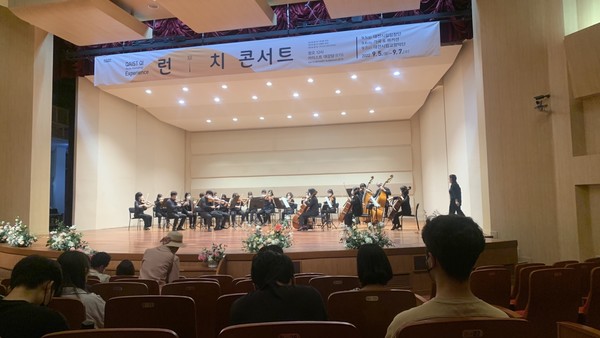From September 5 to September 7, KAIST hosted three consecutive lunchtime orchestral performances in the Auditorium (E15), showcasing music from the Daejeon Philharmonic Choir, the Daejeon Philharmonic Voice and Percussion group, and the Daejeon Philharmonic Orchestra (DPO). The performances included pieces composed by Mendelssohn, Holst, Mozart, Vivaldi, Schumann, Satie, Poulenc, and many others. These recitals were organized by the Graduate School of Culture Technology and held as part of the “QAIST QI (Quite Interesting) Experience”. This event aimed to help expose KAIST students — freshmen, exchange students, and those nearly graduating alike — to not only a small sliver of what classical and music has to offer, but also to the Daejeon Philharmonic Orchestra as a whole.

Exposure to musical culture is admirable, but how does this fit into KAIST’s post-AI plan, QAIST? Standing for “Questioning”, “Advanced Research”, “Internationalization”, “Start-up”, and “Trust”, it is initially difficult to see why these performances were included as part of the QAIST QI Experiences. However, this became much clearer after taking a closer look at the DPO as well as how the recitals were executed.
The DPO is one of Korea’s exemplary orchestras, having toured in the US, Vienna, Praha, Munich, and having performed in multiple European music festivals in the past decade. Despite having taken a break from these international excursions during the pandemic, the orchestra has continued to perform in Daejeon on a regular basis, most notably through their “Masters Series” performances which feature symphonies and concertos from composers in the classical and romantic era. In addition, the Artistic Director and Principal Conductor of the Orchestra, James Judd, has extensive experience as both a musician and a conductor in multiple internationally renowned orchestras, and has performed in some of the greatest music halls in the world, including the Salzburg Mozarteum and Vienna’s Musikverein.
All the performances were very well received. Word of the concerts spread from the first day resulting in a near packed out audience by the third. Among the audience was a mixture of students, faculty, and visitors to the school — all attending for the rare prospect of being able to hear the DPO perform live for free.
An orchestra’s performance is often thought of as not only dictated by the composer’s notes on the score, but also the stories that the conductor and the musicians have to tell based on their own experiences. A typical orchestral performance has a traditional routine; not clapping between movements, an intermission at around the halfway mark, and often at least one encore by the soloist after their performance. These lunchtime performances were structured a little differently. There was an explanation of each piece before the orchestra would start playing, even demonstrating short motifs that would repeat throughout the piece to help the audience recognize them while the orchestra was playing. Notably, a comparison was made between the Korean “Arirang” and the theme in the fourth movement in Holst’s “St. Paul’s Suite”, which was the theme of “Greensleeves”. It was explained that in the same way that “Arirang” is a culturally important song with no known original composer, the theme of “Greensleeves” has a very similar origin.
Explanations like these, along with the backstory of the DPO, very much aligns with the Internationalization goal of QAIST, and this type of promotion is a very refreshing take. QAIST’s agenda is often very forced and blunt, which has both benefits and drawbacks — one of the latter is that we consider its goals as something extra, or something different to how we live our daily lives. We should aim to incorporate these five objectives into our daily lives through subtler means, like these lunchtime concerts, to help prevent students seeing them as an additional agenda enforced on their lives. Hopefully, we will see KAIST come up with more creative ways to promote QAIST, which can be both as didactic and as enjoyable as the lunchtime performances.

